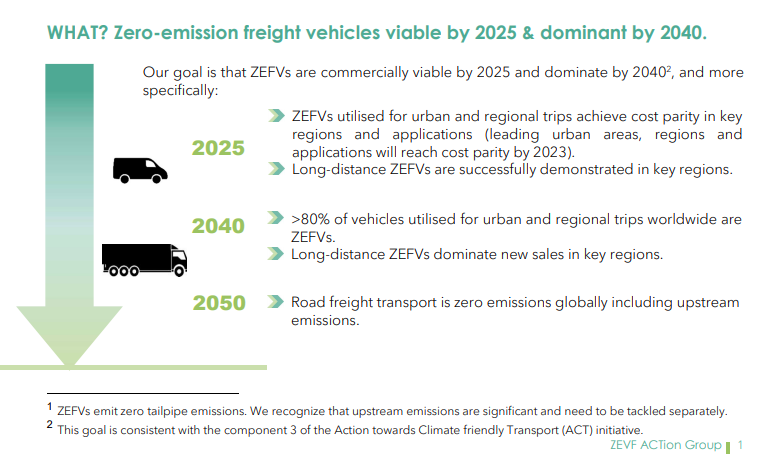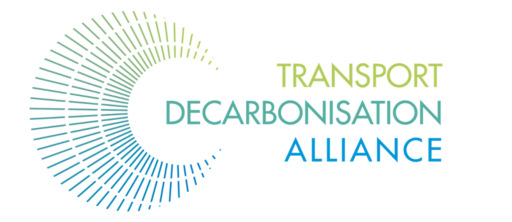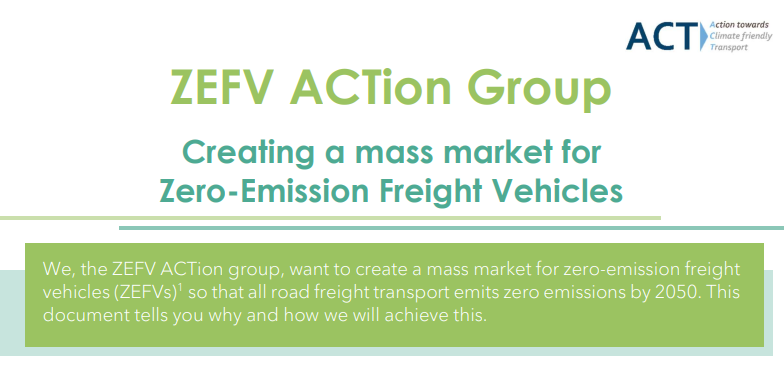ACTION GROUP ZEFV
THE ROAD TO ZERO EMISSIONS FOR FREIGHT VEHICLES
How cities, countries, and companies can spark the shift to decarbonized freight vehicles
THE CHALLENGE
The entire transport sector needs to fully decarbonize by 2050 to meet the Paris Agreement climate targets. Most discussions of zero-emission vehicles focus on automobiles and mass transit, and their market is developing rapidly.
Yet there is one segment that is often overlooked. Freight trucks—long-haul tractor-trailers, regional trucks, urban delivery vans, and other commercial vehicles – represent an enormous and timely opportunity for transport decarbonization.
Worldwide, freight trucks contribute more than 5% of total CO2 emissions. And freight traffic continues to grow. Unless current trends change radically, emissions from road freight vehicles could double by 2050 compared to 2015—making Paris Agreement targets all the harder to meet. Precisely because freight vehicles are relatively small in number and large in carbon contributions, getting zero-emission freight vehicles (ZEFV) on the road will produce an outsize impact on CO2 reduction.
Our goal is that zero-emission freight vehicles (ZEFVs) be commercially viable by 2025 in urban and regional trips, and dominate all road freight segments by 2040. By 2050 we expect the transition to ZEFVs to be complete, with all energy being supplied from renewable sources (Figure 1). Transformation is most likely to succeed if ZEFV deployment is phased:
- Phase one: Start in cities with lighter commercial vehicles and specific use cases: delivery vans, port drayage trucks and utility trucks that return to base for charging overnight.
- Phase two: Deploy ZE versions of heavier vehicles such as garbage trucks, and medium-and heavy-duty regional trucks.
- Phase three: Benefiting from longer research and development, make electric long-haul tractor-trailers ready to roll between cities and countries over longer distances.
* based on the CALSTART drive to zero theory of change.

Driving together for success: policy, infrastructure, demand, and supply
Getting to zero-emission freight requires supply, demand, policies, and infrastructure, and these strategies are designed to address the key barriers to faster ZEFV adoption:
- A large range of ZEFVs is available for all types of services and goods transport.
- Policymakers show leadership and adopt policies to drive faster ZEFV adoption.
- Urban and interoperable user-friendly energy infrastructure is available for all vehicle types in all regions.
- ZEFVs achieve cost parity with internal combustion engine technologies.
- Fleet owners and operators understand which ZEFV models are available and best suited for their operations, can build the business case to invest, and train workforce.
- Investors and freight users support and encourage the use of ZEFVs over fossil fuels.
The ACTiongroup ZEFV led by TDA, The Climate Group/ EV100 and CALSTART/Drive to Zero are working together to jumpstart action in all needed areas. Here is a preliminary list of priorities and commitments to faster ZEFV adoption.
COUNTRIES
- Publicize a long-term vision for zero emissions freight transportation, including road freight
- Develop strict CO2-reduction targets for vans and trucks along with production and sales quotas for ZE freight vehicles (ZEFV Mandate).
- Create financial incentives for ZEFVs
- Earmark funding for ZE freight vehicles in post-Covid-19 recovery packages
- Invest in R&D for long-distance heavy trucking (the toughest technical challenge)
- Join the EV30@30 Campaign
- Sign the Drive to Zero pledge for commercial vehicles, and agree to work together to accelerate early markets for zero- and near-zero emission trucks, buses and off-road equipment;
CITIES
- Sign the C40 Green and Healthy Streets Declaration. This means you commit to procuring only zero-emission buses from 2025, and creating large zones where only ZE vehicles may enter, by 2030. Join 35 cities and counting who have already signed up.
- Create ZE zones for freight trucks and vans before 2030. For example, Netherlands committed to implement these by 2025. TDA’s how-to guide for ZE zones will be available in September 2020.
- Sign the Drive to Zero pledge for commercial vehicles, and agree to work together to accelerate early markets for zero- and near-zero emission trucks, buses and off-road equipment;
COMPANIES
- Join EV100 and commit to transitioning your fleets to electric, by 2030:
- all vehicles up to 3.5 tonnes, plus
- 50% of vehicles between 3.5 and 7.5 tonnes.
As of mid-2020, over 70 large companies have made the pledge, leading to a commitment, amongst others, to purchase over 160,000 commercial electric vehicles. Over 12,000 are already on the road.
- Sign the Drive to Zero pledge for commercial vehicles, and agree to work together to accelerate early markets for zero- and near-zero emission trucks, buses and off-road equipment;
- If you cannot commit yet, you can join the non-binding TDA/ Call for Zero Emission Freight Vehicles, assembled to show potential demand for commercial vehicles worldwide. To date about 78 organisations have signed with a total of over 260,000 freight vehicles:
- Include ZEFVs in your company-specific Roadmap to reduce logistics emissions by 30% by 2030 and reach net-zero emissions by 2050. Calculate and report your emissions using the GLEC Framework, including CO2e impacts from ZEFVs. Or join the GLEC Partnership of more than 90 multinational companies, industry associations, programs experts, and other stakeholders, and led by Smart Freight Centre.
- Join the industry pathways to net-zero emissions within the Mission Possible Platform. The WEF will support public and private sector partners working on the industry transition towards net-zero greenhouse gas emissions by 2050 for (amongst others) heavy-duty road transport.
MEMBERS OF ACTION GROUP ZEFV INCLUDE
ACTIVITIES AND EVENTS OF THE ACTION GROUP ZEFV
Regional Virtual Forum Series: Supply and demand dialogues to speed up vehicle availability
This series of events is initiated by the Transport Decarbonisation Alliance (TDA), The Climate Group/EV100, CALSTART/Drive to Zero to foster dialogue between supply and demand of zero-emission commercial vehicles. The aim is to accelerate the development of the zero-emission commercial vehicle market and in particular, foster supply-demand dialogues. Results will be conveyed to high-level decision-makers at UNFCCC COP26 and further key moments in the run-up to the international climate negotiations.
Past and upcoming sessions in this regional series include:
- KICK-OFF SESSION: Getting Zero-emission vans and Trucks on the Road May 27th 2020
- Regional Session EU September 1st 2020
- Regional Session USA September 3rd 2020
- Regional Session India September 10th 2020
- GETTING ZERO-EMISSION VANS AND TRUCKS ON THE ROAD! INTERNATIONAL Climate Week NYC September 22nd 2020
- En Route to COP26 Session November 2020 (tbc)

